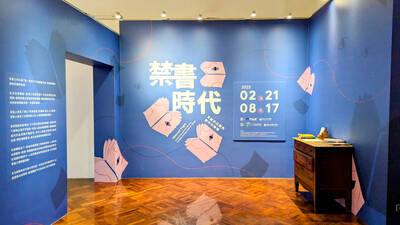A sultry sea mist blankets New Taipei City as I pedal from Tamsui District (淡水) up the coast. This might not be ideal beach weather but it’s fine weather for riding –– the cloud cover sheltering arms and legs from the scourge of the subtropical sun.
The dedicated bikeway that connects downtown Taipei with the west coast of New Taipei City ends just past Fisherman’s Wharf (漁人碼頭) so I’m not the only cyclist jostling for space among the SUVs and scooters on National Highway No. 2. Many Lycra-clad enthusiasts are racing north on stealthy Giants and Meridas, rounding “the crown coast” of Taiwan ahead of the midday heat.
The next dedicated bikeway –– and my humble destination –– is located a further eight kilometers up the road in Sanjhih District (三芝). It bridges two tourist beaches Chienshuiwan (淺水灣) and Baishawan (白沙灣) hence the name, Shuangwan Bike Path (雙灣) meaning “Double Bay.”

Photo: Thomas Bird
Although passing motor vehicles are unnerving, there is a cycle-lane (part of the national Cycling Route No. 1) tracing the fringe of the blacktop. Traffic is light in the forenoon.
The beginning of the Shuangwan Bike Path is marked without ceremony at a branch of 7-Eleven advertising itself as a cyclist’s “rest station” where a number of bikers have hauled-up to breakfast on boiled tea eggs and refill their water bottles.
Inland, there’s a cluster of concrete towers looking out over the Taiwan Strait like stone sentinels. Across the road, a shabby row of restaurants advertising “pizza” and “seafood” block Chienshuiwan’s seaside park from view of the highway.

Photo: Thomas Bird
It’s a further 10 minutes heavy-pedaling before the junction onto Chihsin Road (車新路) liberates my velo from the highway hustle –– a gear change both literal and figurative. The buzz of scooters is promptly supplanted by the hiss of insects. An ancient fisherwoman sporting an enormous bamboo hat sits on an old stone wall. Beyond her, the rice fields lie fallow, farmed only by worm-seeking egrets and their avian kin.
THE FONGJHIHMEN BIKEWAY
Crossing Sanzhan Bridge (三棧橋), I hang left at onto Tianliao Road that borders the tiny hamlet of Datianliao (大田寮). There’s a free carpark here that is all but free from cars, and a small passage that leads onto a windswept stretch of coast where two fishermen are busy baiting their hooks.

Photo: Thomas Bird
This also marks the beginning (or end) of the Fongjhihmen Bikeway (風芝門), a 4.5 kilometer-long section of the Shuangwan Bike Path, that according to the tourist blub, was made by repurposing “a former country road” and some “coastal wooden paths.” Significantly, cars and motorcycles are forbidden here.
You only need to pedal a few meters past the entrance stone to experience what it’s like to live in a world segregated from the internal combustion engine. The bicycle positions me perfectly to absorb the natural world’s chorus.
Spring has truly sprung and butterflies are dancing in the air over the bikeway, while track-side wildflowers are in full bloom. The sound of the surf melds with the pervasive birdsong,

Photo: Thomas Bird
After pedaling for some minutes, I notice two giant raptors circling overhead.
“They’re serpent eagles,” says Willis Chen (陳威志) who is walking the bikeway with a camera. “I’m looking to photograph a Eurasian Hoopoe,” he says, showing me a picture of an exotic bird on his phone. “I’ve heard somebody spotted one out here.”
I concede that I haven’t seen one, although I confess that the number of birds I’ve already seen has been quite unexpected.

Photo: Thomas Bird
“Springtime is peak birding season in Taiwan,” he tells me. “They’re making nests and laying eggs. In the summer, they migrate north because of the heat.”
The heat comes as the sun burns through the haze, bleaching the bikeway with yellow light. I take a quick rest beside a statue of three soldiers standing guard next to an abandoned old blockhouse, then push on, crossing a stream and tracing its bank until the bikeway becomes a coastal boardwalk.
On the beach, families are making sandcastles from the so-called “iron sand” –– a mixed of white coral and volcanic rock –– that according to a tourist signpost, can be attracted by a magnet. Out at sea, the greenish rocks that line the shore are another unique geological attribute of the area, I learn, “Algal reefs” that grow just one centimeter every 10 years but are, nonetheless, an essential habitat for various small fish, crustaceans and shellfish.

Photo: Thomas Bird
Given this rich maritime habitat, it comes as no surprise when the dedicated bikeway ends at Linshanbi Fishing Port (麟山鼻漁港), a rectangular harbor where several blue junks are moored. The boats have eyes painted on the bows, a tradition, I’d read, to help sailors find their way home in heavy seas.
COFFEE BY THE CAPE
A hill path leads to Hi La Vu Opening (嗨!老屋營業中) a somewhat eccentrically branded, if colorful restaurant, which affords diners unrivalled views of the harbor.

Photo: Thomas Bird
I sip a slow coffee, lost in the vista for a time, but eventually summon the energy to continue along the bike path. I still need to get to Baishawan if I am to complete the journey.
The route passes behind Linshan Cape — a peninsular that is popular with walkers — then runs down a tree-lined hill to the Baishawan Visitor Center, concluding at a junction of the provincial highway.
At the road’s edge stands Guanhang Temple (觀航寺), decorated with pretty yellow lanterns and scented with sandalwood. It’s forecourt is an ideal space to turn the bike around and complete the Shuangwan loop by following the bikeway back south again.

Photo: Thomas Bird

From censoring “poisonous books” to banning “poisonous languages,” the Chinese Nationalist Party (KMT) tried hard to stamp out anything that might conflict with its agenda during its almost 40 years of martial law. To mark 228 Peace Memorial Day, which commemorates the anti-government uprising in 1947, which was violently suppressed, I visited two exhibitions detailing censorship in Taiwan: “Silenced Pages” (禁書時代) at the National 228 Memorial Museum and “Mandarin Monopoly?!” (請說國語) at the National Human Rights Museum. In both cases, the authorities framed their targets as “evils that would threaten social mores, national stability and their anti-communist cause, justifying their actions

Taiwanese chip-making giant Taiwan Semiconductor Manufacturing Co (TSMC) plans to invest a whopping US$100 billion in the US, after US President Donald Trump threatened to slap tariffs on overseas-made chips. TSMC is the world’s biggest maker of the critical technology that has become the lifeblood of the global economy. This week’s announcement takes the total amount TSMC has pledged to invest in the US to US$165 billion, which the company says is the “largest single foreign direct investment in US history.” It follows Trump’s accusations that Taiwan stole the US chip industry and his threats to impose tariffs of up to 100 percent

In the run-up to World War II, Admiral Wilhelm Canaris, head of Abwehr, Nazi Germany’s military intelligence service, began to fear that Hitler would launch a war Germany could not win. Deeply disappointed by the sell-out of the Munich Agreement in 1938, Canaris conducted several clandestine operations that were aimed at getting the UK to wake up, invest in defense and actively support the nations Hitler planned to invade. For example, the “Dutch war scare” of January 1939 saw fake intelligence leaked to the British that suggested that Germany was planning to invade the Netherlands in February and acquire airfields

The launch of DeepSeek-R1 AI by Hangzhou-based High-Flyer and subsequent impact reveals a lot about the state of the People’s Republic of China (PRC) today, both good and bad. It touches on the state of Chinese technology, innovation, intellectual property theft, sanctions busting smuggling, propaganda, geopolitics and as with everything in China, the power politics of the Chinese Communist Party (CCP). PLEASING XI JINPING DeepSeek’s creation is almost certainly no accident. In 2015 CCP Secretary General Xi Jinping (習近平) launched his Made in China 2025 program intended to move China away from low-end manufacturing into an innovative technological powerhouse, with Artificial Intelligence